[English] 日本語
 Yorodumi
Yorodumi- PDB-6q9o: HDM2 (17-111, WILDTYPE) COMPLEXED WITH COMPOUND 10 AT 1.21A; Stru... -
+ Open data
Open data
- Basic information
Basic information
| Entry | Database: PDB / ID: 6q9o | ||||||
|---|---|---|---|---|---|---|---|
| Title | HDM2 (17-111, WILDTYPE) COMPLEXED WITH COMPOUND 10 AT 1.21A; Structural states of Hdm2 and HdmX: X-ray elucidation of adaptations and binding interactions for different chemical compound classes | ||||||
 Components Components | E3 ubiquitin-protein ligase Mdm2 | ||||||
 Keywords Keywords | LIGASE / PPI with p53 / inhibitor complex / cell cycle | ||||||
| Function / homology |  Function and homology information Function and homology informationcellular response to vitamin B1 / response to formaldehyde / response to water-immersion restraint stress / response to ether / traversing start control point of mitotic cell cycle / atrial septum development / regulation of protein catabolic process at postsynapse, modulating synaptic transmission / fibroblast activation / Trafficking of AMPA receptors / receptor serine/threonine kinase binding ...cellular response to vitamin B1 / response to formaldehyde / response to water-immersion restraint stress / response to ether / traversing start control point of mitotic cell cycle / atrial septum development / regulation of protein catabolic process at postsynapse, modulating synaptic transmission / fibroblast activation / Trafficking of AMPA receptors / receptor serine/threonine kinase binding / peroxisome proliferator activated receptor binding / negative regulation of intrinsic apoptotic signaling pathway by p53 class mediator / positive regulation of vascular associated smooth muscle cell migration / negative regulation of protein processing / SUMO transferase activity / response to steroid hormone / NEDD8 ligase activity / AKT phosphorylates targets in the cytosol / response to iron ion / atrioventricular valve morphogenesis / endocardial cushion morphogenesis / cellular response to peptide hormone stimulus / ventricular septum development / positive regulation of muscle cell differentiation / cardiac septum morphogenesis / regulation of postsynaptic neurotransmitter receptor internalization / SUMOylation of ubiquitinylation proteins / blood vessel development / ligase activity / cellular response to alkaloid / Constitutive Signaling by AKT1 E17K in Cancer / regulation of protein catabolic process / negative regulation of signal transduction by p53 class mediator / negative regulation of DNA damage response, signal transduction by p53 class mediator / SUMOylation of transcription factors / response to magnesium ion / cellular response to UV-C / protein sumoylation / cellular response to actinomycin D / blood vessel remodeling / cellular response to estrogen stimulus / protein localization to nucleus / ribonucleoprotein complex binding / protein autoubiquitination / positive regulation of vascular associated smooth muscle cell proliferation / NPAS4 regulates expression of target genes / transcription repressor complex / positive regulation of mitotic cell cycle / regulation of heart rate / proteolysis involved in protein catabolic process / positive regulation of protein export from nucleus / ubiquitin binding / response to cocaine / DNA damage response, signal transduction by p53 class mediator / Stabilization of p53 / establishment of protein localization / Regulation of RUNX3 expression and activity / cellular response to gamma radiation / Oncogene Induced Senescence / RING-type E3 ubiquitin transferase / protein destabilization / Regulation of TP53 Activity through Methylation / cellular response to growth factor stimulus / response to toxic substance / centriolar satellite / cellular response to hydrogen peroxide / protein polyubiquitination / ubiquitin-protein transferase activity / disordered domain specific binding / p53 binding / endocytic vesicle membrane / ubiquitin protein ligase activity / Signaling by ALK fusions and activated point mutants / Regulation of TP53 Degradation / positive regulation of proteasomal ubiquitin-dependent protein catabolic process / negative regulation of neuron projection development / 5S rRNA binding / protein-containing complex assembly / ubiquitin-dependent protein catabolic process / Oxidative Stress Induced Senescence / cellular response to hypoxia / Regulation of TP53 Activity through Phosphorylation / amyloid fibril formation / proteasome-mediated ubiquitin-dependent protein catabolic process / regulation of cell cycle / postsynaptic density / Ub-specific processing proteases / protein ubiquitination / response to xenobiotic stimulus / protein domain specific binding / response to antibiotic / negative regulation of DNA-templated transcription / positive regulation of cell population proliferation / apoptotic process / ubiquitin protein ligase binding / positive regulation of gene expression / negative regulation of apoptotic process / nucleolus / glutamatergic synapse / enzyme binding Similarity search - Function | ||||||
| Biological species |  Homo sapiens (human) Homo sapiens (human) | ||||||
| Method |  X-RAY DIFFRACTION / X-RAY DIFFRACTION /  SYNCHROTRON / SYNCHROTRON /  MOLECULAR REPLACEMENT / MOLECULAR REPLACEMENT /  molecular replacement / Resolution: 1.21 Å molecular replacement / Resolution: 1.21 Å | ||||||
 Authors Authors | Kallen, J. | ||||||
 Citation Citation |  Journal: Chemmedchem / Year: 2019 Journal: Chemmedchem / Year: 2019Title: Structural States of Hdm2 and HdmX: X-ray Elucidation of Adaptations and Binding Interactions for Different Chemical Compound Classes. Authors: Kallen, J. / Izaac, A. / Chau, S. / Wirth, E. / Schoepfer, J. / Mah, R. / Schlapbach, A. / Stutz, S. / Vaupel, A. / Guagnano, V. / Masuya, K. / Stachyra, T.M. / Salem, B. / Chene, P. / ...Authors: Kallen, J. / Izaac, A. / Chau, S. / Wirth, E. / Schoepfer, J. / Mah, R. / Schlapbach, A. / Stutz, S. / Vaupel, A. / Guagnano, V. / Masuya, K. / Stachyra, T.M. / Salem, B. / Chene, P. / Gessier, F. / Holzer, P. / Furet, P. | ||||||
| History |
|
- Structure visualization
Structure visualization
| Structure viewer | Molecule:  Molmil Molmil Jmol/JSmol Jmol/JSmol |
|---|
- Downloads & links
Downloads & links
- Download
Download
| PDBx/mmCIF format |  6q9o.cif.gz 6q9o.cif.gz | 99.6 KB | Display |  PDBx/mmCIF format PDBx/mmCIF format |
|---|---|---|---|---|
| PDB format |  pdb6q9o.ent.gz pdb6q9o.ent.gz | 74.9 KB | Display |  PDB format PDB format |
| PDBx/mmJSON format |  6q9o.json.gz 6q9o.json.gz | Tree view |  PDBx/mmJSON format PDBx/mmJSON format | |
| Others |  Other downloads Other downloads |
-Validation report
| Arichive directory |  https://data.pdbj.org/pub/pdb/validation_reports/q9/6q9o https://data.pdbj.org/pub/pdb/validation_reports/q9/6q9o ftp://data.pdbj.org/pub/pdb/validation_reports/q9/6q9o ftp://data.pdbj.org/pub/pdb/validation_reports/q9/6q9o | HTTPS FTP |
|---|
-Related structure data
| Related structure data |  6q96C  6q9hC  6q9lC  6q9qC  6q9sC  6q9uC  6q9wC  6q9yC 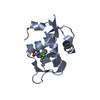 4oq3S S: Starting model for refinement C: citing same article ( |
|---|---|
| Similar structure data |
- Links
Links
- Assembly
Assembly
| Deposited unit | 
| ||||||||
|---|---|---|---|---|---|---|---|---|---|
| 1 | 
| ||||||||
| 2 | 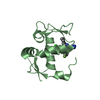
| ||||||||
| Unit cell |
|
- Components
Components
| #1: Protein | Mass: 11156.052 Da / Num. of mol.: 2 / Fragment: N-terminal domain, p53 binding domain Source method: isolated from a genetically manipulated source Source: (gene. exp.)  Homo sapiens (human) / Gene: MDM2 / Plasmid: pET28-derived vector / Production host: Homo sapiens (human) / Gene: MDM2 / Plasmid: pET28-derived vector / Production host:  References: UniProt: Q00987, RING-type E3 ubiquitin transferase #2: Chemical | #3: Water | ChemComp-HOH / | |
|---|
-Experimental details
-Experiment
| Experiment | Method:  X-RAY DIFFRACTION / Number of used crystals: 1 X-RAY DIFFRACTION / Number of used crystals: 1 |
|---|
- Sample preparation
Sample preparation
| Crystal | Density Matthews: 1.91 Å3/Da / Density % sol: 35.72 % / Mosaicity: 0.241 ° |
|---|---|
| Crystal grow | Temperature: 298 K / Method: vapor diffusion, hanging drop / pH: 8 / Details: 2.4M AmSO4, 0.1M NaCitrate, 0.2M NaCl, 0.1M TRIS |
-Data collection
| Diffraction | Mean temperature: 100 K / Serial crystal experiment: N |
|---|---|
| Diffraction source | Source:  SYNCHROTRON / Site: SYNCHROTRON / Site:  SLS SLS  / Beamline: X10SA / Wavelength: 1 Å / Beamline: X10SA / Wavelength: 1 Å |
| Detector | Type: MARMOSAIC 225 mm CCD / Detector: CCD / Date: Mar 25, 2009 |
| Radiation | Monochromator: SI 111 channel / Protocol: SINGLE WAVELENGTH / Monochromatic (M) / Laue (L): M / Scattering type: x-ray |
| Radiation wavelength | Wavelength: 1 Å / Relative weight: 1 |
| Reflection | Resolution: 1.21→50 Å / Num. obs: 50939 / % possible obs: 99.5 % / Redundancy: 6.1 % / Rmerge(I) obs: 0.069 / Χ2: 1.054 / Net I/σ(I): 28.44 |
| Reflection shell | Resolution: 1.21→1.25 Å / Redundancy: 5.6 % / Rmerge(I) obs: 0.262 / Mean I/σ(I) obs: 4.54 / Num. unique obs: 5176 / Χ2: 1.827 / % possible all: 95.6 |
-Phasing
| Phasing | Method:  molecular replacement molecular replacement |
|---|
- Processing
Processing
| Software |
| ||||||||||||||||||||||||||||||||||||||||||||||||||||||||||||
|---|---|---|---|---|---|---|---|---|---|---|---|---|---|---|---|---|---|---|---|---|---|---|---|---|---|---|---|---|---|---|---|---|---|---|---|---|---|---|---|---|---|---|---|---|---|---|---|---|---|---|---|---|---|---|---|---|---|---|---|---|---|
| Refinement | Method to determine structure:  MOLECULAR REPLACEMENT MOLECULAR REPLACEMENTStarting model: 4OQ3 Resolution: 1.21→20 Å / Cor.coef. Fo:Fc: 0.97 / Cor.coef. Fo:Fc free: 0.97 / SU B: 0.966 / SU ML: 0.02 / SU R Cruickshank DPI: 0.0426 / Cross valid method: THROUGHOUT / σ(F): 0 / ESU R: 0.043 / ESU R Free: 0.037 Details: HYDROGENS HAVE BEEN ADDED IN THE RIDING POSITIONS U VALUES : REFINED INDIVIDUALLY
| ||||||||||||||||||||||||||||||||||||||||||||||||||||||||||||
| Solvent computation | Ion probe radii: 0.8 Å / Shrinkage radii: 0.8 Å / VDW probe radii: 1.2 Å | ||||||||||||||||||||||||||||||||||||||||||||||||||||||||||||
| Displacement parameters | Biso max: 43.32 Å2 / Biso mean: 12.183 Å2 / Biso min: 5.73 Å2
| ||||||||||||||||||||||||||||||||||||||||||||||||||||||||||||
| Refinement step | Cycle: final / Resolution: 1.21→20 Å
| ||||||||||||||||||||||||||||||||||||||||||||||||||||||||||||
| Refine LS restraints |
| ||||||||||||||||||||||||||||||||||||||||||||||||||||||||||||
| LS refinement shell | Resolution: 1.211→1.242 Å / Rfactor Rfree error: 0 / Total num. of bins used: 20
|
 Movie
Movie Controller
Controller



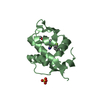
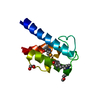

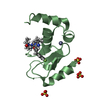

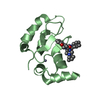
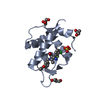
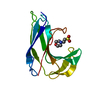
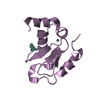
 PDBj
PDBj












